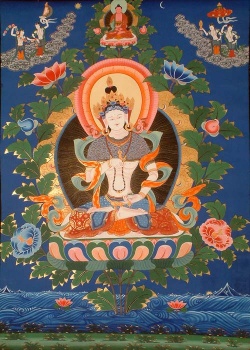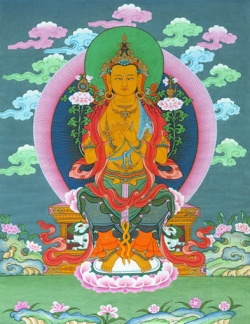Kilesa
'Defilements', are Mind-defiling, unwholesome qualities. Vis.M. XXII, 49, 65:
"There are 10 Defilements, thus called because they are themselves defiled, and because they defile the Mental factors associated with them. They are:
- (1) Greed (Lobha),
- (2) hate (dosa),
- (3) Delusion (Moha),
- (4) conceit (Māna),
- (5) speculative views (Ditthi),
- (6) skeptical Doubt (vicikicchā),
- (7) Mental torpor (Thīna),
- (8) restlessness (Uddhacca);
- (9) shamelessness (Ahirika),
- (10) lack of Moral dread or unconscientiousness (Anottappa)."
For 1-3, s. Mūla; 4, s. Māna; 5, s. Ditthi; 6-8, s. Nīvarana; 9 and 10, s. Ahirika-anottappa.
The ten are explained in Dhs. 1229f and enumerated in Vibh. XII.
No classification of the k. is found in the Suttas, though the term occurs quite often in them. For the related term, Upakkilesa ('impurities') different lists are given - (App.).
kilesa: 'defilements', are mind-defiling, unwholesome qualities. Vis.M. XXII, 49, 65: "There are 10 defilements, thus called because they are themselves defiled, and because they defile the mental factors associated with them. They are:
(1) greed (lobha),
(2) hate (dosa),
(3) delusion (moha),
(4) conceit (māna),
(5) speculative views (diṭṭhi),
(6) skeptical doubt (vicikicchā ),
(7) mental torpor (thīna),
(8) restlessness (uddhacca);
(9) shamelessness (ahirika ), (
10) lack of moral dread or unconscientiousness (anottappa)." For 1-3, s. mūla; 4, s. māna; 5, s. diṭṭhi; 6-8, s. nīvaraṇa; 9 and 10, s. ahirika -anottappa.
The ten are explained in Dhs. 1229f and enumerated in Vibh. XII. No classification of the k. is found in the Suttas , though the term occurs quite often in them. For the related term, upakkilesa (q.v.; 'impurities') different lists are given - (App.).
kilesa : [m.] passion; lust; depravity; impurity.
Description: Kilesa (and klesa) [from kilissati) 1. stain, soil, impurity, fig. affliction; in a moral sense, depravity, lust. Its occurrence in the Piṭakas is rare; in later works, very frequent, where it is approx. tantamount to our terms lower, or unregenerate nature, sinful desires, vices, passions.
1. Kilesa as obstacle (see ˚āvaraṇa, ˚ -- sampayutta, ˚ -- vippayutta, ˚pahāna) Ps i.33; Sdhp 455; bhikkhu bhinnakileso "one whose passions are broken up" Vḅh 246, PvA 51; upasanta kileso "one whose passions are calmed" PvA 230; no ce pi jātu puriso kilese vāto yathā abbhaghanaŋ vihāne Sn 348; pariyodapeyya attānaŋ cittaklesehi paṇḍito S v.24=A v.232, 253=Dh 88. 2. Occurs in such combinations as kilesā ca khandhā ca abhisankhārā ca Nd2 487; kilesa+khandha: Ps i.69<-> 72; ii.36, 140; cp. Vbh 44, 68; kilesa+saŋsāra PvA 7; kammaŋ kilesā hetu saŋsārassa Nett 113, cp. 191. <-> 3. kilesa also occurs in a series explanatory of taṇhā, in the stereotype combn of t., diṭṭhi, kilesa "clinging to existence, false ideas and lust" (see Nd2 s. v. taṇhā v.). -- 4. In the same function it stands with rāga, viz. rāga dosa moha kilesa, i. e. sensuality, bewilderment and lust (see Nd2 s. v. rāga ii.), cp. Dhs 982, 1006. <-> The grouping as dasa kilesa -- vatthūni is: lobha dosa moha māna diṭṭhi vicikicchā thīnaŋ uddhaccaŋ ahirikaŋ anottappaŋ Dhs 1548=Vbh 341; Vism 683; mentioned at Ps i.130. -- These with the exception of the last two, are also grouped as aṭṭha k˚ -- vatthūni at Vbh 385. -- As three kilesas (past, present and future) at Psii.217. -- 5. The giving up of kilesa is one of the four essentials of perfection: the recognition of evil, the removal of its source (which is kilesa), the meditation on the Path, and the realization of the extinction of evil (see Nd2 s. v. dukkha ii.). Kilesa in this connection interchanges with samudaya, as denoting the origin of evil; cp. samudayo kilesā Nett 191.
-- āvaraṇa the obstacle of lust Vbh 342 Pug 13; Vism 177; ˚āvaraṇatā id. A iii.436; -- kkhaya the destruction of lust Bdhd 81; -- paripantha danger of lust Jvi.57; -- pahāna the giving up of worldly lust Vin iii.92 sq., iv.25; Bdhd 129, 131; -- puñja the heap of lusts; consisting of ten qualities, viz. the four āhārā (etc. four of each:), vipallāsā, upādānāni, yogā, gandhā, āsavā, oghā, sallā, viññāṇaṭṭhitiyo, agatigamanāni. Nett 113, 114; 116 sq. -- bhūmi the substratum or essence of lust Nett 2, 192; there are four mentioned at Nett 161: anusaya˚, pariyuṭṭhāna˚, saŋyojana˚, upādāna˚; -- māra death which is the consequence of sinful desire DhAi.317 (in expl. of Māra); -- vatthūni (pl.) the (10) divisions of kilesa (see above) Dhs 1229, 1548; Vism 20. -- vinaya the discipline of lust Nett 22; -- vippayuttafree from lust (dhamma principles, to which belongs Nibbāna) Dhs 1555; -- sampayutta connected or affected with lust Dhs 1554 (as 12 principles); Vbh 18=30=44=56, 68, 80, 96, 120, 323.
Description: kilesa, klesa(<[kilissati污染]): m. 污染


